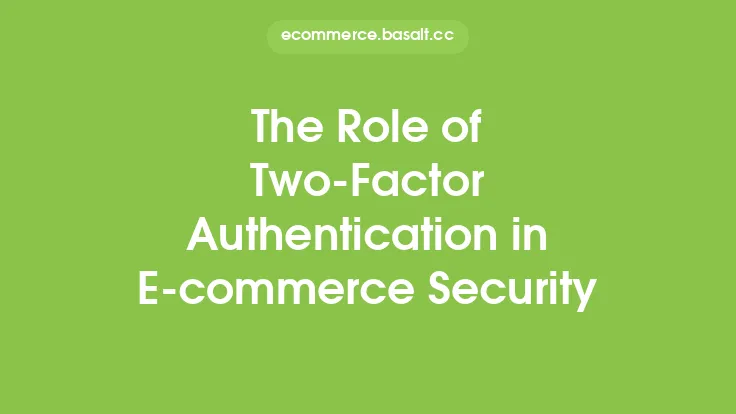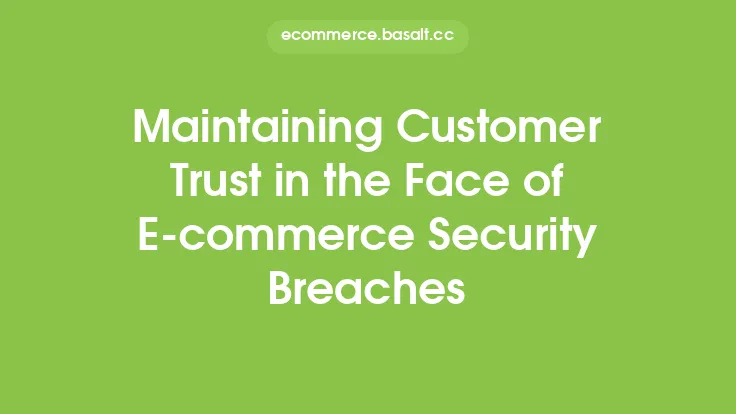In today's digital age, e-commerce has become an integral part of our lives, with millions of people around the world making online purchases every day. However, with the rise of e-commerce, the risk of cyber threats and data breaches has also increased. One of the most effective ways to protect e-commerce websites and their customers from these threats is by implementing two-factor authentication (2FA). In this article, we will explore the role of 2FA in e-commerce security and why it is essential for online businesses.
What is Two-Factor Authentication?
Two-factor authentication is a security process that requires users to provide two different authentication factors to access a website, application, or system. The first factor is typically a password or PIN, while the second factor can be a variety of things, such as a code sent to a user's phone or email, a biometric scan (e.g., fingerprint or facial recognition), or a physical token. The purpose of 2FA is to add an extra layer of security to the traditional password-based authentication system, making it more difficult for hackers to gain unauthorized access to sensitive information.
Benefits of Two-Factor Authentication in E-commerce
The benefits of 2FA in e-commerce are numerous. Firstly, it provides an additional layer of security, making it more difficult for hackers to access customer accounts and sensitive information. This, in turn, helps to prevent data breaches and protect customer data. Secondly, 2FA helps to reduce the risk of phishing attacks, as even if a hacker has obtained a customer's password, they will not be able to access the account without the second factor. Finally, 2FA can help to increase customer trust and confidence in an e-commerce website, as it demonstrates a commitment to security and protecting customer data.
Types of Two-Factor Authentication
There are several types of 2FA that can be used in e-commerce, including:
- SMS-based 2FA: This involves sending a code to a user's phone via SMS, which they must then enter to access their account.
- Email-based 2FA: This involves sending a code to a user's email, which they must then enter to access their account.
- Authenticator app-based 2FA: This involves using a dedicated authenticator app, such as Google Authenticator or Authy, to generate a time-based one-time password (TOTP).
- Biometric-based 2FA: This involves using biometric data, such as fingerprints or facial recognition, to authenticate users.
- Physical token-based 2FA: This involves using a physical token, such as a USB drive or a smart card, to authenticate users.
Implementing Two-Factor Authentication in E-commerce
Implementing 2FA in e-commerce is relatively straightforward. Most e-commerce platforms, such as Shopify and Magento, offer built-in 2FA functionality or integrate with third-party 2FA services. To implement 2FA, online businesses can follow these steps:
- Choose a 2FA method: Select a 2FA method that suits your business needs, such as SMS-based 2FA or authenticator app-based 2FA.
- Configure 2FA settings: Configure the 2FA settings on your e-commerce platform, including setting up the 2FA method and defining the authentication rules.
- Enroll customers: Enroll customers in the 2FA program, either by requiring them to opt-in or by making 2FA mandatory for all customers.
- Test 2FA: Test the 2FA system to ensure it is working correctly and that customers can access their accounts without issues.
Best Practices for Two-Factor Authentication
To get the most out of 2FA, online businesses should follow these best practices:
- Make 2FA mandatory: Make 2FA mandatory for all customers to ensure that all accounts are protected.
- Use a variety of 2FA methods: Offer a variety of 2FA methods to cater to different customer preferences and needs.
- Use a secure 2FA protocol: Use a secure 2FA protocol, such as TOTP or HMAC-based one-time password (HOTP), to prevent hacking and phishing attacks.
- Monitor 2FA activity: Monitor 2FA activity to detect and respond to potential security threats.
- Educate customers: Educate customers about the benefits and importance of 2FA to increase adoption and usage.
Conclusion
In conclusion, two-factor authentication is a critical component of e-commerce security, providing an additional layer of protection against cyber threats and data breaches. By implementing 2FA, online businesses can protect customer data, reduce the risk of phishing attacks, and increase customer trust and confidence. With various types of 2FA available, online businesses can choose the method that best suits their needs and follow best practices to ensure effective implementation and usage. As e-commerce continues to grow and evolve, the importance of 2FA will only continue to increase, making it an essential investment for online businesses that want to stay ahead of the security curve.





